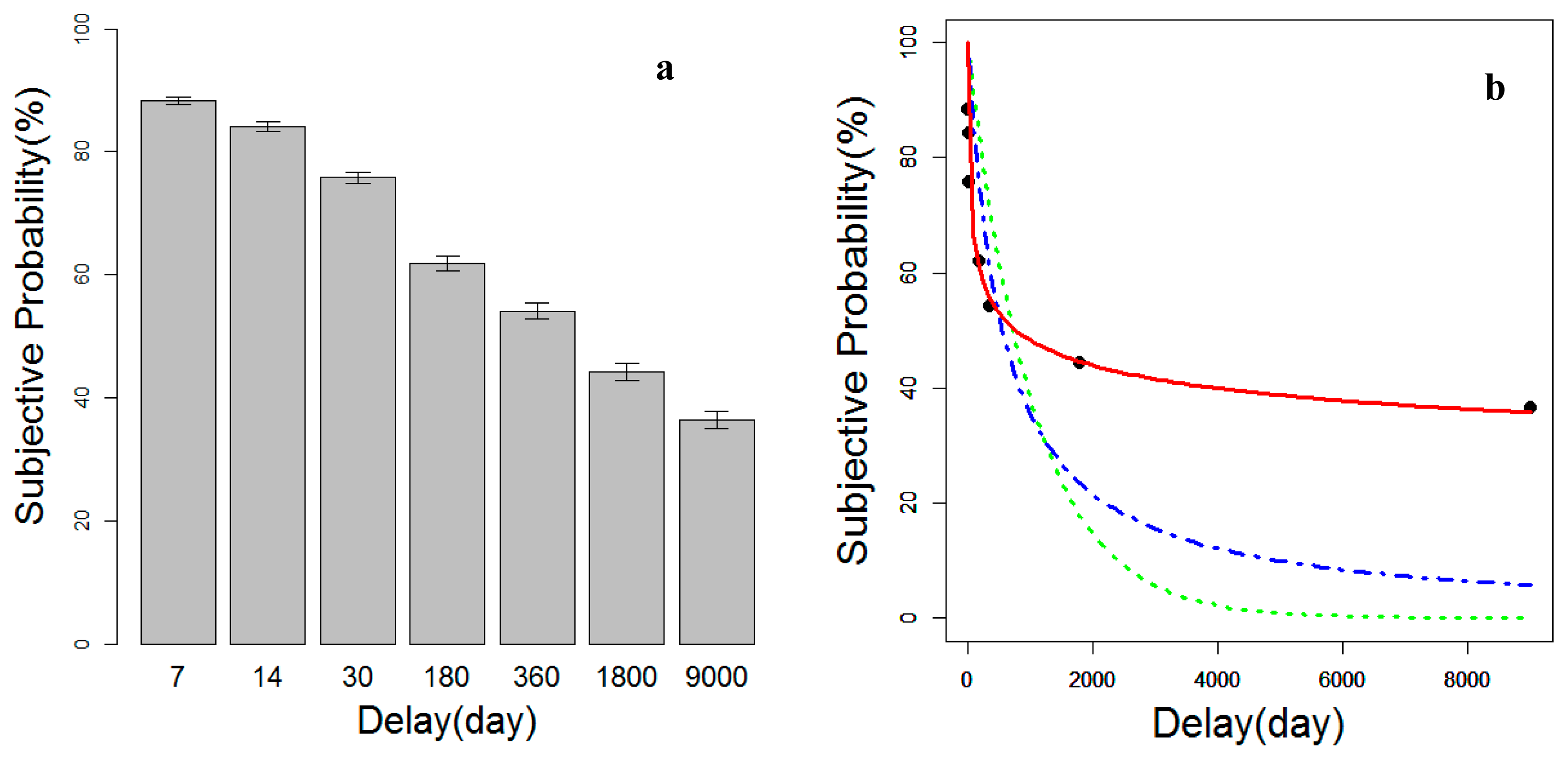The Q-Exponential Decay of Subjective Probability for Future Reward: A Psychophysical Time Approach
Abstract
:1. Introduction
1.1. Subjective Probability and Intertemporal Choice
1.2. Theoretical Background
2. Results and Discussion
2.1. Physical Time-Decay of Subjective Probability for Future Reward
2.2. Psychophysical Time for Delay until Receipt of Reward
2.3. Psychophysical Time-Decay of Subjective Probability for Future Reward
3. Experimental Section
4. Conclusions
Acknowledgments
Author Contributions
Conflicts of Interest
References
- Cajueiro, D.O. A note on the relevance of the q-exponential function in the context of intertemporal choices. Physica A 2006, 364, 385–388. [Google Scholar]
- Takahashi, T. Loss of self-control in intertemporal choice may be attributable to logarithmic time-perception. Med. Hypotheses 2005, 65, 691–693. [Google Scholar]
- Takahashi, T. Theoretical frameworks for neuroeconomics of intertemporal choice. J. Neurosci. Psychol. Econ 2009, 2, 75–90. [Google Scholar]
- Takahashi, T.; Oono, H.; Radford, M.H.B. Psychophysics of time perception and intertemporal choice models. Physica A 2008, 87, 2066–2074. [Google Scholar]
- Sozou, P.D. On hyperbolic discounting and uncertain hazard rates. Proc. R. Soc. Lond. B 1998, 265, 2015–2020. [Google Scholar]
- Takahashi, T.; Ikeda, K.; Hasegawa, T. A hyperbolic decay of subjective probability of obtaining delayed rewards. Behav. Brain Funct 2007, 3, 52. [Google Scholar]
- Glimcher, P.W.; Fehr, E. Neuroeconomics Decision Making and the Brain; Academic Press: New York NY, USA, 2013. [Google Scholar]
- Samuelson, P. A note on measurement utility. Rev. Econ. Stud 1937, 4, 155–161. [Google Scholar]
- Naudts, J. Generalised Thermostatistics; Springer: London, UK, 2011. [Google Scholar]
- Tsallis, C. Introduction to Nonextensive Statistical Mechanics Approaching a Complex World; Springer: New York, USA, 2009. [Google Scholar]
- Yamano, T. Some properties of q-logarithm and q-exponential functions in Tsallis statistics. Physica A 2002, 305, 486–496. [Google Scholar]
- Borges, E.P. A possible deformed algebra and calculus inspired in nonextensive thermostatistics. Physica A 2004, 340, 95–101. [Google Scholar]
- Han, R.; Takahashi, T. Psychophysics of valuation and time perception in temporal discounting of gain and loss. Physica A 2012, 391, 6568–6576. [Google Scholar]
- Takahashi, T.; Han, R. Psychophysical neuroeconomics of decision making: Nonlinear time perception commonly explains anomalies in temporal and probability discounting. Appl. Math 2013, 4, 1520–1525. [Google Scholar]
- Zauberman, G.; Kim, B.K.; Malkoc, S.A.; Bettman, J.R. Discounting time and time discounting: Subjective time perception and intertemporal preferences. J. Mark. Res 2009, 46, 543–556. [Google Scholar]
- Bradford, D.W.; Dolan, P.; Galizzi, M.M. Looking Ahead: Subjective Time Perception and Individual Discounting; Working Paper of Centre for Economic Performance: London, UK, 2014. [Google Scholar]
- Varian, H.R. Microeconomic Analysis; W W Norton & Co Inc: New York, NY, USA, 1992. [Google Scholar]
- Burnham, K.P.; Anderson, D.R. Model Selection and Multimodel Inference: A Practical Information-Theoretic Approach; Springer: New York, NY, USA, 2002. [Google Scholar]
- Tsigelny, I.F.; Kouznetsova, V.L.; Baitaluk, M.; Changeux, J.P. A hierarchical coherent-gene-group model for brain development. Genes Brain Behav 2013, 12, 147–165. [Google Scholar]
- Mello, B.A.; Cajueiro, D.O. A note on the connection between the Tsallis’ thermodynamics and cumulative prospect theory. Rev. Bras. Econ. Empr 2010, 10, 31–36. [Google Scholar]
- Tversky, A.; Kahneman, D. Advances in prospect theory: Cumulative representation of uncertainty. J. Risk Uncertain 1992, 5, 297–323. [Google Scholar]
- Destefano, N.; Martinez, A.S. The additive property of the inconsistency degree in intertemporal decision making through the generalization of psychophysical laws. Physica A 2011, 390, 1763–1772. [Google Scholar]



| Exponential | Hyperbolic | q-Exponential | |
|---|---|---|---|
| AIC | 67.54205 | 64.26132 | 23.16847 |
| Parameter | k1 = 0.0018215 | k0 = 0.027814 | kq = 0.027814, q = 6.295212 |
| Linear Function | Power Function | Logarithmic Function | |
|---|---|---|---|
| AIC | 89.05314 | 61.38481 | 58.18276 |
| Parameter | α = 0.02149 | α = 77.98593, β = 0.08858 | α = 12.222, β = 171.403 |
| Exponential | Hyperbolic | q-Exponential | |
|---|---|---|---|
| AIC | 57.00633 | 58.59702 | 37.25649 |
| Parameter | k1 = 0.0038631 | k0 = 0.004874 | kq = 0.001593, q = 4.819 |
© 2014 by the authors; licensee MDPI, Basel, Switzerland This article is an open access article distributed under the terms and conditions of the Creative Commons Attribution license (http://creativecommons.org/licenses/by/3.0/).
Share and Cite
Takahashi, T.; Tokuda, S.; Nishimura, M.; Kimura, R. The Q-Exponential Decay of Subjective Probability for Future Reward: A Psychophysical Time Approach. Entropy 2014, 16, 5537-5545. https://doi.org/10.3390/e16105537
Takahashi T, Tokuda S, Nishimura M, Kimura R. The Q-Exponential Decay of Subjective Probability for Future Reward: A Psychophysical Time Approach. Entropy. 2014; 16(10):5537-5545. https://doi.org/10.3390/e16105537
Chicago/Turabian StyleTakahashi, Taiki, Shinsuke Tokuda, Masato Nishimura, and Ryo Kimura. 2014. "The Q-Exponential Decay of Subjective Probability for Future Reward: A Psychophysical Time Approach" Entropy 16, no. 10: 5537-5545. https://doi.org/10.3390/e16105537
APA StyleTakahashi, T., Tokuda, S., Nishimura, M., & Kimura, R. (2014). The Q-Exponential Decay of Subjective Probability for Future Reward: A Psychophysical Time Approach. Entropy, 16(10), 5537-5545. https://doi.org/10.3390/e16105537




